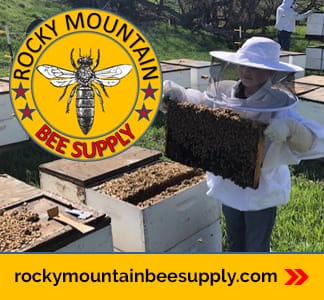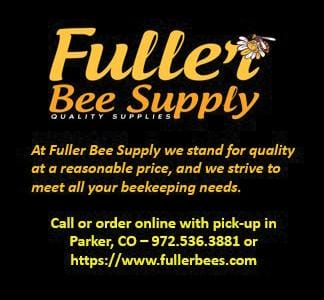Honey Bee Health
This section has been created with the beekeeper in mind and is always under construction. It focuses on bee diseases and parasites. The goal is to make it easy for you, the beekeeper, to find the necessary diagnostic information to make an informed decision on what may be affecting the health of your hive. This is a basic guide only. There is a boatload of information out on the web. You will need to assess the data and make the best management decision you can with that data. Research, decide, act and evaluate.
Brood Diseases:
As of 1 January 2017 You Will Need a Veterinarian to Diagnose American and European Foulbrood and Prescribe Antibiotics!!! You can purchase a “home test kit” for either EFB or AFB. They work like a home pregnancy test. These test results may help you in your decision-making, but your vet may require an independent diagnosis.
There is an apiary callout (visit) charge, a diagnostic kit charge, and a fee for writing the ‘scrip’ if needed. The ‘scrip’ is for a specific hive(s) for a specific length of time. It’s a good idea to have your hives numbered to facilitate this. Remember that EFB and PMS may have similar symptoms. Check/treat your hives for mites first to rule out PMS. It is up to the discretion of the veterinarian whether to prescribe antibiotics for AFB or to recommend destruction of the hive.
OR…Please visit these sites and talk to your veterinarian about establishing a relationship to provide care for your bees. https://pollinators.msu.edu/bees-need-vets/
http://www.honeybeeveterinaryconsortium.org/
Great News! We have some Colorado veterinarians who will do apiary visits, diagnose AFB and EFB, and prescribe antibiotics if appropriate.
- Dr. Carolina Nyarady (Northern Colorado, cnyarady@me.com) is a licensed small animal Veterinarian in Colorado & a 3rd generation beekeeper. She has been a certified Master Beekeeper for almost 20 years and has kept bees in Colorado for over 25 years, as well as maintained Apiaries in other states and other continents.
She is the founder of the CSBA Master beekeeping program and one of its first instructors. Carolina also teaches beekeeping courses at all levels (for about 20 years). This has included presenting Bee Diseases at the Annual CSBA meetings as well as presenting Bee Diseases at the Colorado Veterinary Medical Association annual meeting. - Dr. Amy Franklin (Loveland, Colorado; 97O-692-3O48; amyfranklindvm@gmail.com) is a current Colorado Journeyman Beekeeper Candidate and has served on national boards concerning honey bee health, and is more than willing to apply her DVM to honey bee and apiary issues.
- Dr. Dyanne Caprio (Eastern Colorado) is retired, but has kept bees for many years and may serve as needed. Contact info@coloradobeekeepers.org to be connected.
American Foulbrood (AFB)
American Foulbrood is probably the most feared of all bee diseases. AFB is highly contagious and is spread through the use of contaminated equipment and through robbing of the diseased hive by other bees. It is caused by the Paenibacillus larvae bacterium. The bacteria feed on the larvae and kill them in their pre-pupal and pupal stages. AFB has a distinct rotten flesh odor, which most beekeepers will notice before they will notice the rest of the symptoms. AFB forms spores, which are kind of like seeds, and are highly resistant to heat, cold and chemicals and are not killed by antibiotics. They remain viable for 70+ years in contaminated equipment.
Here is a link to the USDA/ARS Bee Disease Diagnosis Lab where you can send samples for diagnosis (It may take 2-5 weeks): http://www.ars.usda.gov/Services/docs.htm?docid=2882. Here is a short youtube video on determining if you have American Foulbrood in your hive: http://www.youtube.com/watch?v=v2Aa56jut7Y. Not into videos? Here is a nice .pdf. And another.
If you have confirmed that you have American Foulbrood, the classic recommendation has been to burn the hive, bees and all, to prevent further transmission to other healthy colonies: yours, your neighbors’, and feral colonies. There are other, less effective, options, however. Here are some videos and links to AFB treatments.
Both European and American Foulbrood Treatment Options by Jamie Ellis, University of Florida
Chemical Treatment Options by Dr. Eric Mussen, UC Davis
Moving an Infected Colony to Eliminate AFB by Tim Schuler, NJ Department of Agriculture
European Foulbrood (EFB)
European Foulbrood is caused by the bacterium, Melissococcus pluton, which does not form spores and so is less virulent and more easily treated than AFB. It typically affects younger, uncapped, as well as capped larvae, which distinguishes it from AFB. While healthy larvae are pearly white and glistening, larvae affected by EFB may appear yellowish, melted or dry. In the early stages the white, thready tracheal system may be visible. The odor is not as foul as AFB, but may be sour or yogurty. The dead larvae are not ropy as in AFB. EFB may appear similar to parasitic mite syndrome (PMS). Here is a diagnostic video from Dr. Jamie Ellis of the University of Florida. Here is a link to some diagnostic images for reference.
Chemical treatment of EFB is the same as AFB. Chemical Treatment Options by Dr. Eric Mussen, UC Davis
Requeening is generally helpful also.
Chalkbrood
Chalkbrood is a brood disease caused by a fungus, Ascophaera apis. Chalkbrood produces bee larva “mummies” which you can see on the bottom or entrance board of a colony. These mummies are whitish or gray. Here is a picture of a heavy infestation of chalkbrood. This fungus is usually present in bee colonies, but becomes pathogenic when young brood is exposed to low temperatures. Typically in CO, chalkbrood is seen in the spring. It is rarely fatal. A colony entering into spring will generally “fix” the problem by merely growing and heading into larger populations for summer. If workers are not uncapping and removing mummies (hygienic) the hive can be requeened with hygienic stock. If the condition persists into warm weather, the queen can be caged for 10-14 days to allow the workers to clean up the problem. Dispose of heavily infected combs.
There are more brood diseases out there than these three–but these represent the most common diseases found here.
Varroa Mite (Varroa destructor)
It is hard to imagine beekeeping before Varroa but a mere 30 years ago, this was the case! Varroa destructor is aptly named and is the cause of a tremendous percentage of colony losses annually, especially for new beekeepers. In addition to feeding on the hemolymph (bee blood) of the developing bees, varroa transmit a number of fatal viruses, for which there is no treatment. Of course, a hive weakened by the varroa/virus complex is more susceptible to the other two of the Big Three, pesticides, and poor nutrition. Here is a link to a PDG (pretty darn good) description of Varroa from, not surprisingly, the University of Florida. Oh, if only we had this type of support from our universities here in Colorado! Too busy working on wheat, I guess.
There are a lot of different ways to manage Varroa. You can manage it with in-hive miticides or you can try to manage it with non-chemical alternatives or any combination in between. No matter what treatment method you use, you need to know whether you need to treat at all first and whether your treatments are working. MONITOR your MITES. There are 2 methods of determining the Varroa load in your bee hive: alcohol wash and powdered sugar roll.
Links:
Honey Bee Health Coalition’s Tools for Varroa Management includes a downloadable updated guide, data sheets and videos:
http://honeybeehealthcoalition.org/Varroa/#videos
http://www.cals.ncsu.edu/entomology/apiculture/pdfs/2.03%20copy.pdf
http://scientificbeekeeping.com/varroa-management/












